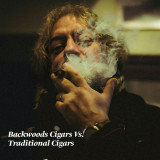The Art of Cigar Rolling: From Seed to Smoke

The art of cigar rolling is a journey. It begins with a tiny seed and ends with a finely crafted smoke.
This process is steeped in tradition. It's a craft passed down through generations, requiring skill and patience.
From the cultivation of tobacco to the final roll, each step is crucial. The quality of the cigar depends on it.
In this guide, we'll explore the art of cigar rolling. We'll delve into the process, from seed to smoke, and the role of the cigar rolling machine in modern manufacturing.
The Heritage of Cigar Rolling
Cigar rolling has a rich heritage that spans centuries. It's a tradition deeply rooted in culture and craftsmanship.
Countries like Cuba and the Dominican Republic are renowned for their cigar-making legacy. Each region brings its own unique methods and flavors.
Throughout history, cigar rolling has been an art form. It's an integral part of community life and cultural identity.
Cultivating the Perfect Tobacco Leaf
The journey of a cigar begins with the tobacco leaf. Selecting quality seeds is crucial for the best results.
Ideal climate and soil play a significant role in growth. Tropical regions offer perfect conditions for robust flavors.
Tending to tobacco plants requires care and precision. Proper cultivation ensures leaves reach their full potential before harvesting.
The Fermentation and Aging Process
Fermentation is pivotal in enhancing tobacco's flavor profile. This process reduces harshness and enriches aroma.
Time is a friend during aging. The leaf gradually matures, deepening its complexity and richness.
Aged tobacco yields a smoother smoke. Master blenders monitor and adjust conditions to ensure optimal results.
The Trinity of a Cigar: Wrapper, Binder, and Filler
A cigar's essence lies in its three main parts: the wrapper, binder, and filler. Each plays a crucial role.
The wrapper is the outermost leaf. It influences the cigar's appearance and a significant portion of its flavor.
Inside, the binder holds it all together. The filler, a blend of different leaves, creates the cigar's distinctive taste and aroma.
The Artisanal Skill of Hand-Rolling Cigars
Hand-rolling cigars is a revered craft, requiring precision and expertise. Each cigar is a unique piece of art.
Craftsmen must work meticulously, ensuring the perfect draw and even burn. This demands years of practice and dedication.
The sensory experience of hand-rolling is unmatched. Rolling involves tactile assessments, shaping, and a personal touch, making every cigar special.
Cigar Rolling Machines: Modernity Meets Tradition
Cigar rolling machines represent a blend of innovation with timeless craft. These machines enhance efficiency in production.
While lacking the personal touch, machines deliver consistency and speed. They play a significant role in meeting global demand.
Many enthusiasts still prefer hand-rolled cigars for their unique character. Yet, machines offer a modern alternative, preserving aspects of tradition.
The Final Touch: Quality Control and Storage
Quality control is crucial in ensuring a premium cigar. Each cigar undergoes strict checks for consistency and construction.
Proper storage preserves the cigar’s freshness and flavor. Maintaining optimal humidity levels is essential for an ideal smoking experience.
Conclusion: The Cultural Tapestry of Cigar Rolling
Cigar rolling is more than just a craft; it is a rich tradition. It weaves stories of culture and heritage.
This process unites farmers, artisans, and connoisseurs. Each plays an integral role in preserving the essence of cigar making.
From seed to smoke, cigar rolling offers a sensory journey. It remains a cherished art form celebrated worldwide.
Recent Posts
-
Backwoods vs Traditional Cigars: Flavor & Experience
Cigars are celebrated for their unique flavors, meticulous craftsmanship, and cultural significance …11th Sep 2025 -
Best Cigar and Bourbon Pairings for Every Aficionado
Best Cigar and Bourbon Pairings for Every Aficionado Pairing a fine cigar with a glass of bourbon i …10th Sep 2025 -
Swisher Sweets Seasonal Flavors You Need to Try
In today's competitive tobacco market, swisher sweets has carved a niche with its innovative season …9th Sep 2025



